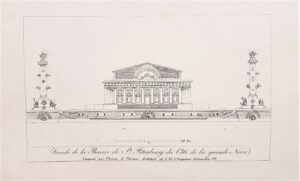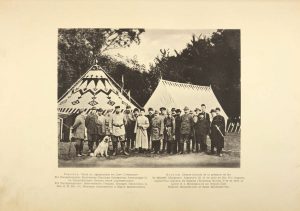Our Notes & References
Remarkably illustrated Old Believers’ manuscript with 52 full-page hand-coloured images, most depicting astounding afterlife trials of a human soul in an exceptionally dynamic and engaging way.
“The most comprehensive description of the afterlife’s trials in sinfulness in Greco-Slavic literature” (Gribov).
“As an illustrated encyclopaedia of Christian eschatology, The Life [Vita] of St Basil the Younger was an extraordinary phenomenon in the history of Slavonic Russian book art in the 17th-early 20th centuries, and a favourite work of Russian scribes, calligraphers and miniaturists” (Gudkov, our translation here and below). Written in Greek in the second half of the 10th century in Constantinople, this “monumental ‘epic of death’ (F. Batiushkov), which stunned the imagination of mediaeval readers with its vivid mystical pictures of the netherworld” (Gribov) is attributed to a certain Gregory, St Basil’s student and disciple who narrates this account.
Beginning with the story of St Basil (d. 944-52) who was arrested on suspicion of espionage, tortured and miraculously survived to live a long and righteous life, the Vita is however as much a work of visionary literature as it is a saint’s hagiography: “The author… is evidently less concerned with [Basil’s life] as such than with using him as a pretext for recounting numerous other matters of interest to him” (Ryden). The major part of the text is a remarkable description of Gregory’s vision of the posthumous ordeals [mytarstva] through 21 aerial toll-houses, or telonia, of the soul of the venerable old woman Theodora (also Feodora). Widowed early, Theodora led a pious life and stayed under the guidance of St Basil as his servant till her death “in extreme old age in the year 940” (Janos). Upon her death, Gregory besought his teacher to reveal to him Theodora’s after-death fate, and the next night he saw the woman in his dream, detailing on her experience. Theodora’s story continues with Gregory’s vision of the Last Judgement, comparable to the “Revelation of St John” in terms of its expressiveness of the apocalyptic imagery. (Theodora of Constantinople has been venerated as a saint in the Christian Orthodoxy.)
Although the vision of the aerial toll-houses is already present in the works of 4-6th century authors (John Chrysostom, Macarius of Egypt, Symeon Stylites the Younger, etc.), The Life of St Basil the Younger is “[the first] detailed and systematic account of the tollhouses’ procedure” (Afentoulidou). Notably, this first elaboration of the eschatological myth not only personifies a human soul undergoing the after-death trials but gives this role to a woman. In contrast to that, the 9th-century Chronicle of Georgios Monachos describes telonia of an unnamed Carthaginian man who dies in sin, while most other works simply prophesy the similar posthumous ordeals in general. The choice of Theodora as the main character perhaps intends to highlight the uniformity of all humans’ destinies after death: “Basil cannot exempt Theodora from the tollhouses, he will pass through them himself someday, and the deeds of both the holy man and the slave woman are converted into the same currency” (Afentoulidou).
The first Slavonic translation appeared at the end of the 11th century, followed around the 14th century by another one with a shortened description of Basil’s life. The third translation, by the important Metropolitan Dimitrii Rostovskii (1651-1709), dates from the late 17th century. Similar to the later manuscripts and printed editions, the present example combines different translations using the content of the second translation with a text mostly influenced by Rostovskii’s work.
The significance of The Life of St Basil the Younger for Mediaeval Russian literature “is attested by the inclusion of its fragments into different contemporary works”, such as the Povest vremennykh let [Primary Chronicle] (c. 1113) and various editions of Prolog, the compilation of brief hagiographical Slavic texts of Lives of the Saints arranged in calendar order (Pentkovskaia). The Vita also “had a grand influence on the Russian Medieval folklore and fine art, particularly the iconography of the Last Judgement” (Dergacheva).
During the 17th-19th centuries, the expressive and dramatic eschatology made the The Life of St Basil the Younger particularly popular with the Old Believers in Russia, for this work’s apocalyptic visions had much in common with their expectations of the Second Coming; “without eschatology, it is impossible to comprehend Old Believers holistically” (Raskov). The Old Believers, also known as raskolniki (“splitters, schismatics”), had opposed Patriarch Nikon’s reforms of Orthodoxy in the late 1650s, and had since experienced bans and persecution. Since the 18th century, individual plots and compositions illustrating the Vita became widespread in handwritten and printed Old Believers’ productions. The first printed edition was published around 1795 by F. Kartashev in Klintsy and, by the 1910s, it underwent at least six printed Old Believers’ editions (Pentkovskaia).
This manuscript is particularly remarkable for the quantity and the style of its coloured images: it contains many illustrations in text and 52 lively and eloquent full-page miniatures, all painted in contemporary bold colours. The first images show individual episodes from the life of St Basil, while most of the other ones focus on the journey of Theodora’s soul, led by two angels through the toll-houses, each ruled by various demons who hold lists of her sins and call her soul into hell. At the top left are the scales to measure the good deeds (on the dexter side) in relation to the bad ones (on the sinister side).
In contrast to many other depictions of telonia, this manuscript’s scenes are remarkably active and… ‘talkative’, showing extremely lively diverse gestures and taking curious poses. At certain toll-houses, such as fornication, demons are pointing at the sins of Theodora’s youth, documented in their scrolls, and are screaming out “siia sotvorila” [“she did it]” and “stoi neidi” [stop, don’t go]. Sometimes the angels reply to demons to defend Theodora and to negotiate (just like attorneys), with their words flowing in the opposite direction, from top to bottom. Demons from other telonia, such as sodomy, have nothing to present against her as they hold the empty scrolls. At the telonia of “remembering evil” demons even express their despair, one crying “woe to us for our work perishes” as he is sitting on the throne which looks as if it is made of snakes and resembles the one of Basil’s evil judge from the saint’s hagiography earlier in the book.
Theodora successfully passes through all the telonia thanks to St Basil’s prayers (according to other interpretations, Basil shares with her his good deeds converted into gold coins that help compensate for her sins); she then, together with the Seraphim, Cherubim and other angels, stands at the gates of Paradise, guarded by Archangel Mikhail, and proceeds to a heavenly garden-city, marvellously depicted on a two-page spread. Before finishing her journey, she is also led through hell, where the angels show her the terrible torments of different sinners receiving punishments according to their sins as they are buried underground and burning in infernal flames. Interestingly, the artist depicts tortures for monks and priests, placing them right next to the thieves, unbelievers and lechers. This allows us to suggest that this manuscript was created by the so-called bespopovtsy, or Priestless Old Believers who renounced all priests after Nikon’s reforms.
The style of the miniatures is unusually spacious and dynamic, with light and soft contours, compared to heavily linear and often repetitive images of the same subjects and scenes from other manuscripts we could find in Russian libraries. While their imagery is influenced by Orthodox icons, our miniatures rather remind of popular lubok prints, widespread in Russia since the late 17th century. The abundance of text within the miniatures also resonates with the lubok tradition that would often replace literature and icons for the Russian peasantry.
Many of this manuscript’s miniatures show traces of pin marks in the outlines, possibly meaning that these images were were used as samples/models through tracing, perhaps for individual lubok sheets, equally popular with Old Believers. We could not find any other Russian manuscript books showing the same tracing technique, nor relevant information about it in Russian reference literature.
This specific characteristics, together with the style of the faces and the decoration of the binding could point towards a production place located in Western Russia, or possibly Belarus or Ukraine.
The paper shows watermarks of Aleksei Zatrapeznyi’s Yaroslavl Manufactory with Yaroslavl’s coat of arms (bear holding a halberd under a crown) and initials “IaMZ” [Iaroslavskaia Manufaktura Zatrapeznogo] in Cyrillic, present in the factory paper in this combination and style around 1750s (Klepikov). Old Believers’ communities were indeed settled in the Yaroslavl and its neighbouring Kostroma regions in the 1750-60s and later; also, around 350 km away from Yaroslavl, the Nizhnii Novgorod region was a major centre for the Priestless Old Believers around the same time.
Rare: we could not find any other manuscripts of this work in libraries outside Russia: Worldcat shows results only for printed editions of the 20th century and later, and we could trace only one manuscript copy of The Life of St Basil the Younger on the market in the West, sold in 1993.
Provenance
Soviet/Russian inscription to lower pastedown; Swiss private collection.
Bibliography
Afentoulidou, Eirini. “Space and Power in Byzantine Accounts of the Aerial Tollhouses”. Cultures of Eschatology: Volume 2: Time, Death and Afterlife in Medieval Christian, Islamic and Buddhist Communities, edited by Veronika Wieser, Vincent Eltschinger and Johann Heiss, Berlin, Boston: De Gruyter Oldenbourg, 2020, pp. 603-615.
Dergacheva I. V., “Vasilii Novyi”, Pravoslavnaia entsiklopediia, Moskva, 2009.
Fr. S. Janos (transl.), “The Nun Theodora of Tsargrad”, Holy Trinity Russian Orthodox Church Calendar.
Gudkov, Aleksei, “«Litsa» sudnogo dnia: illiustrirovannye rukopisi Zhitiia Vasiliia Novogo“, Russkaia vera, 2018.
Gribov Iu. A., Pigin A.V., “Iz Zhitiia Vasiliia Novogo. Khozhdenie Feodory po vozdushnym mytarstvam”, Biblioteka Literatury Drevnei Rusi, Tom 8, Moskva, Nauka, 2003.
Pentkovskaiia T. V., Zhitie Vasiliia Novogo v drevneishem slavianskom perevode, MGU, IAsk, Moskva, 2018.
Raskov, Danila, “Eskhatologiia i aktivnost v miru staroverov”, Christianskoe chtenie, #6, 2012.
Rydén, Lennart, “The Life of St. Basil the Younger and the Date of the Life of St. Andreas Salos”. Harvard Ukrainian Studies, #7, 568–586, 1983.
Physical Description
Folio (32 x 20.5 cm; block 30 x 18.5 cm). Complete manuscript on paper, in Church Slavonic written in black ink, possibly by two hands or more, illustrated; 84 leaves, paginated in Church Slavonic numerals, all pages within a brown ink and watercolour frame, the last leaf blank but with the same frame, the first page being the title, written in green and red ink, with an ornamental floral head-piece in brown, red and green watercolours showing Christ in its centre, and large 5-line B letter in red and black ink with a background of a plant bearing a flower and ?grapes, the letter and background within an ornamental frame, 54 illustrations in text in red, green, brown and blue watercolour occasionally with brown ink, including 52 full-page, many integrating some hand-written text, most with outlines dotted with many close pinholes, some full-page with several miniatures.
Binding
Contemporary Russian full calf over wooden boards, richly tooled, upper cover with central floral ornament, spine with raised bands and floral ornament to compartments, roll-work to boards edges two clasps, pastedowns of yellow paper and gutters reinforced with vellum, block edges black.
Condition
Binding worn and restored but solid, tooling possibly gilt originally, lower hinge repaired, clasps missing, vellum in pastedowns gutters probably later, colour of block edges mostly rubbed away except top edge; pages soiled and stained, occasionally with minor repairs, occasional minor damage or fragility of paper due to pinholes, inks and watercolours, often bleeding through a bit, a couple of later underlining, occasional minor overwriting with modern ink.














